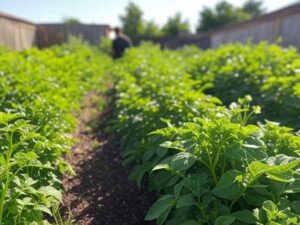How Hard is it to Grow Potatoes?
Growing potatoes in your backyard is surprisingly simple and rewarding, making it an excellent choice for both novice and experienced gardeners. With minimal space, basic soil preparation, and a little patience, you can enjoy the satisfaction of harvesting your own fresh, home-grown potatoes. This root vegetable not only thrives in a variety of climates but also offers flexibility in planting methods, whether you have a sprawling garden or just a few containers on a balcony. Let’s delve into how you can start this effortless journey to potato cultivation.
The Potato Trinity
Soil: Potatoes prefer well-drained, loose soil with a pH between 5.0 and 7.0. Adding compost can help if your soil isn’t ideal.
Light: They need full sun, ideally 6-8 hours daily.
Water: Regular watering is key, especially when the plants are flowering and developing tubers, but over-watering can lead to rot.
Yield and Space
Yield: You can expect about 5 to 10 pounds of potatoes per 10 feet of row, depending on variety, soil quality, and care. In containers, a 5-gallon bucket might yield 1-2 pounds.
Space: Each potato plant needs about 1 to 2 square feet, so in a 100 square foot area, you could potentially plant 50-100 plants.
Growth Time
Time to Harvest: From planting to harvest, potatoes generally take about 70-120 days, depending on the variety: Some potatoes can be harvested in as little as 60-70 days for early varieties, with some main crop potatoes take around 90-120 days.
Recommended Plants Per Person
For a homestead: A general rule of thumb is to plant 10-20 potato plants per person for a year’s supply, considering not just immediate consumption but also storage for winter.
Best and Easiest Varieties for Beginners
Yukon Gold: Known for its versatility, good yield, and buttery flavor. It’s forgiving if you slightly neglect watering or soil conditions.
Red Pontiac: Another beginner-friendly variety, these are easy to grow, have excellent storage capabilities, and are great for boiling or roasting.
Kennebec: These are resilient, with good disease resistance, and produce large, versatile potatoes.
Russet Burbank: If you like baking potatoes, this variety is straightforward but requires more attention to watering due to its larger size.
Soil Preparation for Growing Potatoes
pH Levels: Proper soil preparation is crucial for a successful potato harvest. One of the most important things you can do to prepare for a successful harvest is test your soil. Potatoes grow best in soil with a pH between 5.0 and 7.0. Use a soil test kit to check this. If the soil is too acidic, add lime; if too alkaline, sulfur or organic matter like peat moss can help.
Nutrient Levels: Test for key nutrients like nitrogen (N), phosphorus (P), and potassium (K). Potatoes particularly need potassium for tuber formation.
Choose the Right Location
Select a spot with full sun exposure. Potatoes need at least 6-8 hours of direct sunlight daily. Ensure the area has good drainage. Avoid low spots where water might collect, as potatoes can rot in waterlogged soil.
Preparation: Clear the area of weeds and grass. Weeds compete with potatoes for nutrients and water. Use a garden fork or tiller to break up the soil to a depth of at least 8-12 inches. This improves root penetration and tuber growth. Pull out any rocks or large clumps that could interfere with tuber development. Add compost or well-rotted manure to enrich the soil. This improves soil structure, helps with moisture retention, and provides nutrients. Aim for about 2-3 inches of organic matter mixed into the top layer of soil.
Where do potatoes come from?
It’s that time where we have the old birds, and the bees talk. Interestingly potatoes are not typically grown from seeds in regular gardening practices. Instead, they are grown from what are called seed potatoes. These are whole or cut pieces of mature potatoes that have small sprouts or “eyes.” Each piece should have at least one or two eyes, as these are the points from which new plants will grow.
Here’s why seed potatoes are preferred over true seeds:
Seed potatoes ensure that the offspring will be true to type, providing predictable growth characteristics, taste, and disease resistance, as they are clones of the parent potato. True potato seeds can result in plants with varied traits. Potatoes from seed potatoes grow much faster than those from true seeds. True seed potatoes would need to grow into a plant, then produce tubers, which could take an extra season.
Potato plants do produce berries with seeds, but these are rarely used for growing due to the reasons mentioned above. If you did grow potatoes from true seeds, you might find a wide variation in plant and tuber characteristics, which can be interesting for breeding new varieties but not practical for consistent crop production.
Can I Regrow Store Bought Potatoes?
Yes, you can grow new potatoes from older store-bought potatoes, but there are several considerations to keep in mind:
Advantages:
Store-bought potatoes are readily available, and if they’ve begun sprouting, it’s an easy way to start growing. And it’s often cheaper than buying certified seed potatoes, especially if you already have potatoes at home. Using potatoes that would otherwise go to waste can feel environmentally friendly.
Challenges and Risks:
Many store-bought potatoes are treated with chemicals like chlorpropham to prevent sprouting. While these effects diminish over time, they might delay or inhibit sprouting.
Store-bought potatoes might not be checked for diseases. Planting these could introduce pathogens like potato blight, scab, or fusarium into your garden soil, potentially affecting future crops. You might not know the variety of the potato, which can affect growth habits, yield, and taste.
Considerations:
The yield might not be as predictable or as high as with certified seed potatoes, but it can still be rewarding. Growing from store-bought potatoes can be a fun experiment, especially if you’re just starting out or want to see what happens with what you have.
While you can grow new potatoes from older store-bought ones, there’s a risk of lower success rates and potential disease introduction. For those serious about potato cultivation, certified seed potatoes are recommended. However, for a backyard experiment or to make use of sprouting potatoes, it’s an approach that can work with some caution.
How to Grow Potatoes
1. Pre-Planting:
Chitting: About 4-6 weeks before planting, set seed potatoes in a light, frost-free place to sprout. This isn’t strictly necessary but can jump-start growth.
Potato chitting is the process of encouraging seed potatoes to sprout before planting them in the ground. This practice involves placing seed potatoes in a cool, light place, often in trays or egg cartons with the eyes (buds) facing upwards. The aim is to give the potatoes a head-start on growth, which can lead to an earlier and potentially more bountiful harvest. Here’s how it generally works:
You first need to choose seed potatoes that are firm and free from disease. Then arrange them with the eyes pointing up in a single layer where they can get indirect light, like a windowsill or a cold greenhouse. Let them sit for several weeks (usually 4-6 weeks) until small, sturdy sprouts, or “chits,” appear. Once the chits are about 1-2 cm long, the potatoes can be planted, taking care not to damage the sprouts during planting.
Chitting is particularly beneficial in cooler climates where the growing season might be shorter, helping to maximize the time potatoes have to grow before the first frost. However, it’s not strictly necessary for all varieties or in all climates.
2. Planting:
Start to plant your potatoes after the last frost when soil temperatures are above 45°F.
You want to make sure that the plant seed potatoes about 3-4 inches deep, spacing them about 12 inches apart in rows 2-3 feet apart. As plants grow, mound soil around the stems to cover the tubers, preventing them from turning green and becoming toxic.
3. Care:
The main goal while your potato plants are growing is to keep the soil moist, but not necessarily waterlogged. And it is important to keep the area weed-free to reduce competition for nutrients. Less competition means a greater yield.
4. Harvesting:
New Potatoes: Also known as baby or early potatoes generally smaller, often no larger than a golf ball, though they can be slightly larger depending on the variety. These are harvested before they reach full maturity. They are typically dug up around 2 to 3 months after planting when the plants are still in flower or just after flowering.
Mature Potatoes: These are left in the ground longer, usually harvested 4 to 6 months after planting once the foliage has died back. They are allowed to fully mature and develop their full size and starch content.
Growing your own potato crop in your backyard homestead offers numerous benefits beyond the joy of home gardening. You’ll harvest fresh, flavorful potatoes that are often superior in taste to store-bought varieties, free from the chemicals used in commercial farming. This practice also promotes self-sufficiency, reducing your carbon footprint by cutting down on transportation and packaging. Moreover, potatoes are a versatile crop that can be grown in various soil types and climates, providing a reliable food source year after year. While potentially saving you money and keeping your family well fed.
Try your homegrown potatoes with these awesome compound butter recipes – https://popularbbq.com/delicious-compound-butters-for-every-dish/
Looking to can your potatoes? Check this article out – https://currenthomesteading.com/seal_the_deal_the_home_canning_chronicles_preserving_flavor_one_jar_at_a_time/

